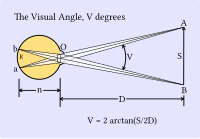Visual angle

Visual angle is like how big something looks to us. Imagine you're standing close to a house, it looks really big, but if you're standing far away from it, it looks tiny. This has to do with the angle of your vision.
When you look at something, the light travels from that thing into your eyes. The angle at which it enters your eyes helps you to determine how far away the thing is and how big it looks to you.
Visual angle is measured in degrees. To be more precise, it's the angle between two imaginary lines drawn from the object to the center of your pupils.
The bigger the visual angle, the larger the object appears to your eyes. So, if you're standing further away from the house, the angle between your pupils and the house is smaller, and the house looks tiny.
Visual angle is important in many areas, including art, psychology, and physiology. For example, in ophthalmology, visual angle is measured to assess the accuracy of vision and to determine if someone needs glasses or contact lenses. In art, visual angle is used to create perspective and depth in paintings and drawings.
So, the next time you look at something, remember that its size is determined by its visual angle, which depends on how far away it is and the angle between your eyes and the object.
When you look at something, the light travels from that thing into your eyes. The angle at which it enters your eyes helps you to determine how far away the thing is and how big it looks to you.
Visual angle is measured in degrees. To be more precise, it's the angle between two imaginary lines drawn from the object to the center of your pupils.
The bigger the visual angle, the larger the object appears to your eyes. So, if you're standing further away from the house, the angle between your pupils and the house is smaller, and the house looks tiny.
Visual angle is important in many areas, including art, psychology, and physiology. For example, in ophthalmology, visual angle is measured to assess the accuracy of vision and to determine if someone needs glasses or contact lenses. In art, visual angle is used to create perspective and depth in paintings and drawings.
So, the next time you look at something, remember that its size is determined by its visual angle, which depends on how far away it is and the angle between your eyes and the object.
Related topics others have asked about:
